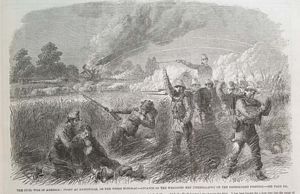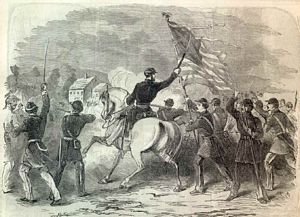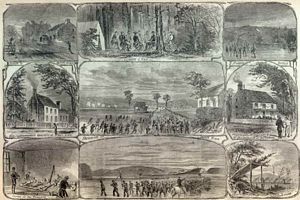Falling Waters
Battlefield Association
The Battle of Falling Waters
July 2, 1861
Early in the war, General Joseph E. Johnston Was ordered into the lower Shenandoah Valley to command the Confederate forces there. Second in command was Col. Thomas J. Jackson.
At the outbreak of the war Jackson was a professor at the Virginia Military Institute (VMI) and when he left VMI to come down the valley he brought with him the Cadet Cannon from VMI and Captain Pendleton, an Episcopal minister who would help form the Rockbridge Artillery.
Col. Jackson established his base camp at Camp Stephens, named after Confederate Vice President Alexander Stephens, north of Martinsburg, along the Valley Turnpike in an area known as the Four Mile Wood.
Jackson’s eyes and ears in the valley was one Lieutenant Colonel J.E.B. Stuart. Jackson knew that there was a large dispatchment of Union Soldiers collected in Williamsport, Maryland, under the command of Robert Patterson, made up mostly of volunteers from Pennsylvania and Wisconsin. They had acted as though they were going to move into Virginia on several occasions, but had not. However, on the morning of July 2, 1861, 4:00 AM they did in fact begin moving across the Potomac and along the Valley Pike towards Martinsburg. Stuarts Cavalry, which had been spread out along the Potomac and hidden in the woods, and made up of many local Berkeley County men, fired upon the Union soldiers as they forged the river.
Stuart immediately sent word to Jackson at Camp Stephens, about nine miles away of the Union movement and Jackson has his troops move north to intercept Patterson.
Patterson’s orders were to keep Johnston confined to the Valley and pinned down in Winchester. He has at his disposal approximately 20,000 men.
Jackson, who has only a fraction of the numbers of men to begin with, only has a portion of those available due to other activities which are on going, such as the destruction of rolling stock of the B&O yard in Martinsburg. Though there are more than 380 Confederates at Falling Waters, it is reported that this is all that is actively engaged in the main battle.
The Confederates set up and are waiting for the Union army to come to them. The site they chose is the Porterfield Farm. (Most of this property and the house is still as it was on that day) The farmhouse was built by Davy Crocket’s grandfather. One of the VMI Cannon was placed in front of the house. Confederate Sharp shooters were in the windows of the house. The main line formed from across the valley pike past the house and into the hills and fields behind the house. About 10:00 AM, the Union army crosses the crest in the road. The Confederates open fire. The battle lasts about two hours. (R.E. Lee Jr. is here)
Lt. Col. Stuart and his men are to the west of the battle and are not engaged. At the end of two hours Jackson knows that he is becoming vastly outnumbered and orders his men to begin pulling back. Stuart seeing this also starts moving south and when he comes over the hill into a hollow (Stumpy Hollow) there is the entire 15th Pennsylvania Inf. (Except their Captain) Stuart, still wearing his Union Blues, is mistaken as one of them and rides right up on them and pulls his pistol and announces that they have been captured. Now the rest of his unit have arrived. Out of 48 men, three resist and are killed. In Jackson’s “Official Report”, he notes that two of these men are killed by “Negro Cavalrymen” under the command of Stuart’s officers.
Jackson withdraws to Darksville. Patterson stops first in Camp Stephens then in Martinsburg. He is disrupted and confused enough that he does not follow his orders and continue after Johnston. He stays in Martinsburg. It is at this time that Belle Boyd shoots and kills one of his men.
Jackson is promoted to Brig. General. Stuart is promoted to full Colonel. General Johnston and Brig. Gen. Jackson move over the Blue Ridge and join up with Beauregard, we have 1st Manassas and Jackson becomes “Stonewall” Jackson. Patterson loses his command.
The Battle of Falling Waters is the first engagement of the Civil War for both Jackson and Stuart. Both men are promoted by General Lee. The first cannon fire of the war in the Shenandoah Valley are from the VMI Cannon at this Battle. It is recorded that we have Negro Confederate Soldiers in this battle. The United States Congress officially lays the fault for the loss of 1st Manassas on the back of Gen. Robert Patterson due to his poor performance and lack of action at and after Falling Waters.
For a more detailed account of the Battle of Falling Waters, the following may be purchased from the Falling Waters Battlefield Association. P.O. Box 339, Falling Waters, WV 25419. Please include $1.55 for shipping.
Blue/Grey Magazine - Battle of Falling Waters - - - $ 4.95
Civil War in Berkeley County - - - - - - - - - - - - - $14.95
(Click on the illustrations below to enlarge)
Engraving from The Illustrated London News
This is an illustration from the August 10, 1861 issue of The Illustrated London News, volume 39, number 1102, page 143. It is titled "The Civil War in America: The fight at Hainsville [sic], on the upper Potomac – Advance of the Wisconsin men (Federalists) on the Secessionist Position". The artist accurately shows the landscape on the Porterfield Farm with the barn burning in the background and shells arching overhead. The soldiers are in a wheat field firing at Confederate troops sheltering behind a fence (hidden by powder smoke and hard to see in this reproduction). These Wisconsin troops are on the east side of the Valley Pike facing south, and the mounted officer is most likely intended to be Colonel Starkweather commanding the 1st Wisconsin Infantry.
The engraver in London has given the soldiers a very distinctive European look, particularly the tampered shakos and the musketeer style boots. Note that the two tall trees in the left distance are the same as those shown in the Harper’s Weekly illustration and montage. Compare the appearance of the soldiers in this engraving from The London Illustrated News with the picture from the Harper’s Weekly. Both illustrations show the Wisconsin troops in roughly the same position, but there are substantial differences in their appearance.
Harper’s Weekly Engraving
This is an engraving from the Harper's Weekly for July 27, 1861 depicting the Battle of Falling Waters. At the time, particularly in the North, the engagement was also known as the Battle of Hoke's Run. This conformed to the Northern practice of naming battles after the closest body of water, whereas the South used the name of the nearest town. Some better known examples of this difference would be Bull Run & Manassas and Antietam & Sharpsburg. This print shows the 1st. Wisconsin Infantry deploying as skirmishers on the Valley Pike in front of the Porterfield house. This impression was recorded by Theodore R. Davis, who is described by Harper's Weekly as "our special artist". This position is roughly equivalent to a present day combat photographer. Harper's describes the process of getting this specific illustration to print:
Our artist with General William's brigade has sent us a sketch, from which we publish an engraving of the Wisconsin Regiment Deploying as Skirmisher's at the Battle of Hoke's Run, on the march of Patterson's Division from Williamsport to Martinsburg.
In other words the artist quickly makes a sketch of the action, which is then sent back to New York, where it is enhanced and turned into an engraving by other artists for reproduction purposes. This process explains why the appearance of the house in the engraving varies somewhat from the actual Porterfield House, although there can be little doubt about where the fight is taking place.
Harper’s Weekly’s actual caption for this illustration read, "Battle of Hoke’s Run – Col. Starkweather with his Wisconsin Regiment deploying as skirmishers". The soldier carrying the flag may be Color Sgt. Frederick Hutching of Co. E before he was shot in the legs. Corporal George M. Sabin of Co. K took the flag from the wounded Hutching and carried it through the remainder of the battle.
Harper’s Weekly Montage of the Battle of Falling Waters
In the July 27, 1861 edition of Harper’s Weekly was a report on the Battle of Falling Waters, also known as Hoke’s Run. Frequently, rather than individual engravings, Harper’s Weekly would print a woodcut montage featuring various scenes related to their report. One of these montages was assembled for the "Skirmish at Hoke’s Run". It was composed of nine scenes which illustrated a "dispatch" printed in that edition. Since in some instances readily identifiable landmarks are shown, these illustrations were surely prepared by an eyewitness accompanying the Union troops. For identification purposes the panels have been assigned numbers from left to right and are described below.
1. "Escape of Rebel Picket"shows McMullin's Rangers firing on some of Stuart's withdrawing Cavalry pickets, which had established their position in and around the turnpike toll house above Watkin's Ferry. As early as 1741 Evan Watkins operated a ferry across the Potomac River, between his property in Virginia (where the newly laid out road started), and the land at the mouth of Conocheague Creek in Maryland. In 1837 the Martinsburg and Potomac Turnpike Company took over the old road (present day Route 11) from Watkin's Ferry to Frederick County, Virginia. Toll houses were established every five miles, with three between between the Potomac River and Martinsburg. The first toll house south of Watkin's Ferry was a small stone structure built immediately next to the road, near the top of the hill. This illustration from Harper's Weekly faces south on the Valley Pike with the toll house on the west side of the road. Unfortunately, while being used as a private dwelling, it burned on February 8, 1985. The remains of the foundation were finally removed in early 2004 to make room for a housing development.
2. "Council of War" shows a meeting of the Union commanders the night before the battle. Harper's Weekly stated that the members were "Generals Williams, Cadwallader, Keim, Nagle, Wynkoop, and Colonels Thomas and Longnecker" and it was held on July 1st. However there are more figures shown than are named. Although not named, it should be assumed that General Patterson was one of those present.
3. "Rangers Fording" shows Captain William McMullin's Independent Rangers crossing the Potomac in the early morning darkness. The Rangers were all volunteer firemen from Philadelphia's Moyamensing Hose Company. They were wearing dark grey uniforms with black trim and white havelocks (a cloth worn under the hat to protect the back of the neck from sunburn).
4. Gen. Cadwallader's Quarters at Hoke's Run" Based on this description and given location, known houses on Hoke's Run in 1861, but primarily on comparison of its dimensions, proportions, window and door size and placement, it appears that Union General Cadwallader used the "Log House on Lick Run Plantation), near the village of Bedington, as his headquarters for only one night. This house had set empty for many years and the log structure had deteriorated to a point where it could not be salvaged. A new residence has been constructed on the footprint of the original house, actually incorporating the old stone chimneys. The owner stated that during construction, the short kitchen chimney was heightened to accommodate the new full second story.
5. "Skirmish at Hoke's Run" (central illustration showing the battle). Facing south on the pike with the Porterfield House to the right. Prominent in this illustration is a large wood pile which is frequently mentioned in first hand accounts of the battle. The Confederate battle line is in the distance and is identified by puffs of smoke. The majority of rebel troops are to the east of the pike. Note that the barn is across the road from the house and there appears to be firing from the barn indicating Confederates inside. Note the tall trees in the distance also appear in the engraving from The London Illustrated News.
6. "Headquarters of Gen. Patterson at Martinsburg" The house of Henry C. Small was used by Union General Robert Patterson as his headquarters when his Federal Troops entered Martinsburg on July 3, 1861. The house stood on the west side of the 500 block of North Queen Street immediately north of the train tracks. it was destroyed by the construction of the underpass in 1917.
7. "Caring for the Wounded" Soldiers injured in the battle were initially carried into various homes and a school house, so it cannot be determined exactly which location is shown here. John W. Curtis, writing in Aler's History of Martinsburg and Berkeley County, states that there were five wounded soldiers in the Porterfield House (note that only four are shown). There is also the possibility that this represents the house of John Gonter, which stood near the present day entrance to the Faslock facility (formerly DuPont). However sources place only three of the Union wounded in his home. Within a few days all the wounded were moved to a hospital in Hagerstown, where at least one more would later die.
8. "Fording" shows the bulk of Patterson's Army crossing the Potomac. On the far shore are the houses and church spire of Williamsport, Maryland. The deep cut of Salisbury Street and the bridge over the C&O Canal are clearly visible. The canal aqueduct over Conococheague Creek appears as the half circle above the horse's tail (note that the aqueduct is actually supported by three arches). The present day Route 11 Bridge would be just to the right of the aqueduct. The hill on the far right is called Doubleday's Hill, for Union Captain (eventually Major General) Abner Doubleday, who had placed artillery there before the move into (West) Virginia. Today this hill has two permanently mounted Civil War cannon replicas with a flag pole placed as a memorial, and is part of the old town cemetery, now called Riverview. The left side of the deep cut has been removed and a residence built there.
9. "Secession Camp" shows lean-to's made of brush, left standing at Camp Stephens. Confederate troops had struck (taken down and folded) the few tents they had, but the 27th Virginia Infantry, in charge of breaking camp, mistakenly left them behind as they withdrew. The Union troops which found these tents promptly destroyed them.
Local
- Home
- Mission
- Battle
- Battlefield Map
- Press Releases
- Join the FWBA
- About the FWBA
- Calm Under Fire
- Favorite Links
- Contacts
Directions
From I-81 take Spring Mills Exit 20, then proceed West on Hammonds Mill Road (WV 901). T.J. Jackson Drive is the first road on the left (south side) approximately 300 yards west of I-81. The library is on the corner, next to, but set back from the CNB Bank, across the street from the Shell Gas Station & Convenience Store. Library Phone Number: (304) 274-3443.


